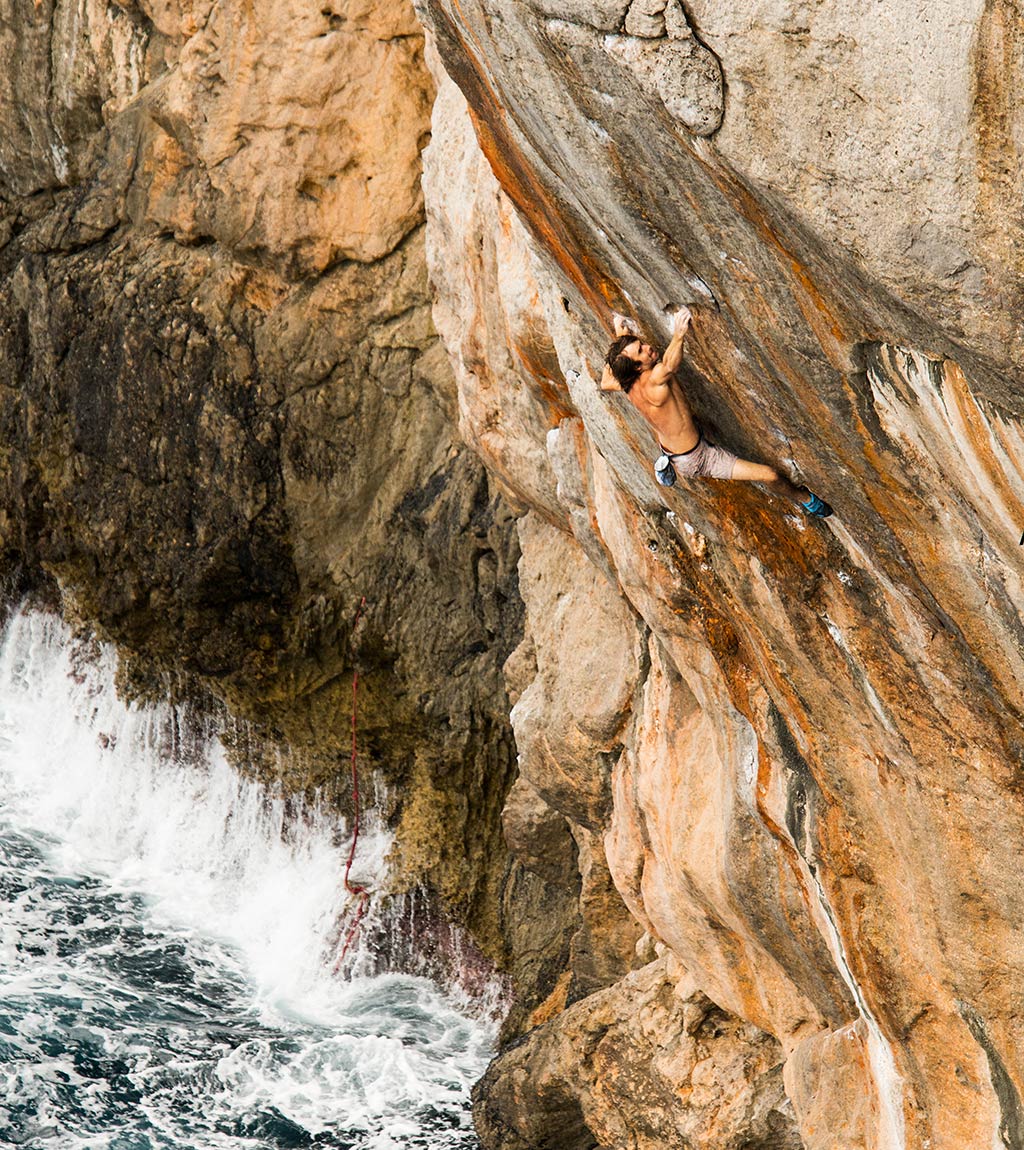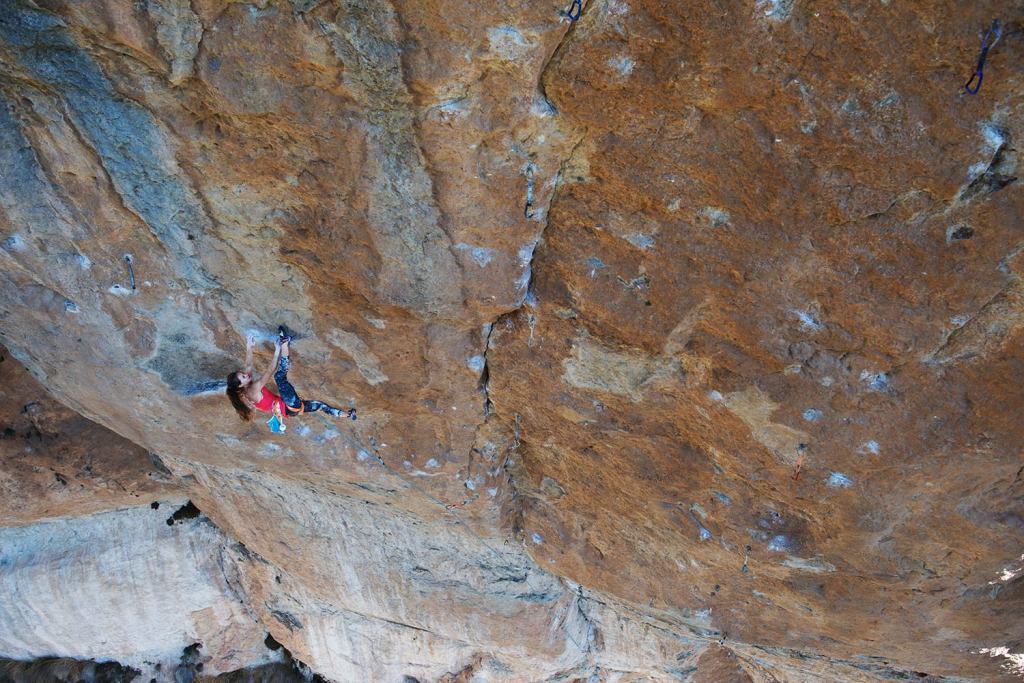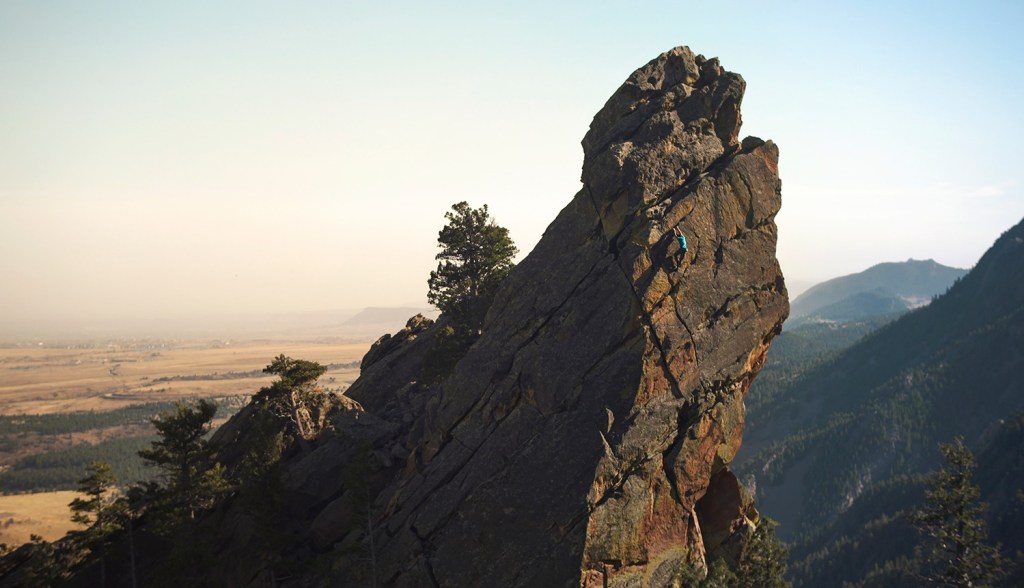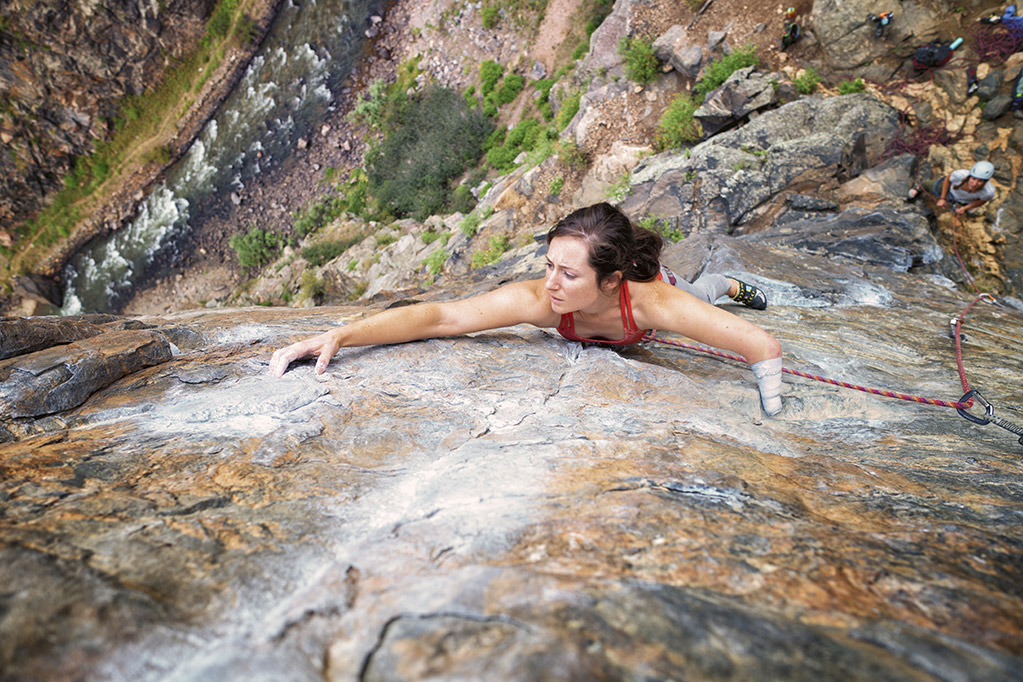Co-op Journal interviews the filmmakers of Reel Rock 12
Each fall, for just over a decade, Reel Rock has been the second most anticipated event, right behind Rocktober’s sending temps. This rock climbing focused film tour, with 380 stops, is a collaboration between Colorado’s Sender Films and New York’s Big UP productions and has become a key rallying point for climbing communities across the country.
We caught up with the directors of each of the four films in RR12 to learn more about the stories they’re telling, the creative process and what most excites them about climbing today.
Above the Sea
Chris Sharma remains the world’s greatest practitioner of deep water soloing—climbing ropeless above the sea. 10 years after his generation-defining ascent of a majestic arch, Chris returns to the Mediterranean island of Mallorca where he discovers a beautiful, sweeping wall with small holds running up its face. If he can link the moves, and endure the numerous heart-stopping plunges into the sea, he will establish what may be the world’s hardest deep water solo climb. Directed by Brett and Josh Lowell

Chris Sharma | Photo: Adam Clark
Brett, tell me about the creative process you and Sharma share.
Brett Lowell: It has really been a blessing working with Chris all these years. He not only crushes everything but is really into the production side of the process also. He is constantly running me from one vantage point to the next upon first showing me a new line of his, making sure we get the best possible angles for shooting.
I was with Chris the first time he went to Mallorca, and his eyes lit up. He’s a Santa Cruz kid, and his dad was a surfer. He has a deep connection to the ocean. As filmmakers, that passion is always what we look for.
We always know when Chris calls all excited about his latest project, it’s going to be amazing. He just doesn’t get inspired by dinky stuff.
How is it that Big UP is routinely on hand for many of any given year’s biggest moments in climbing?
BL: Well, we’ve been doing this for a long time, at this point we are friends with a lot of the athletes doing big stuff. I think it is super important that there is a trust between the climber and filmmakers. Not only for everybody’s safety in these hectic environments but also knowing there will be great content to show from the collaboration.
This project had some heavy elements—the weight of Chris’s mom’s death, and the adult responsibilities of being a dad and business owner—but you didn’t dive too deep or dwell on those aspects. Why?
BL: Our goal for this short film was not to tell Chris’s full in-depth biography but touching on some of the reasons he connected so strongly with the island was important to us.
No shirt, flowing locks, DWS. It’s pretty classic Sharma, and feels like it could have come out at any point in the last 10 years—and I mean that in a good way—how does Chris do it? And what will he do next?
BL: Well, Chris never ceases to amaze me. He has tendons of steel. The real factor for Chris though is how inspired by a climb or a wall he gets. It’s easy to understand why he gets so motivated when you see what he is doing above the ocean in Mallorca … It’s ridiculous.
As for what’s next, who knows? He was just checking lines out in Yosemite with Tommy (Caldwell), and there’s stuff around Barcelona he’s into. And he’s always travelling. Who knows?
What are you excited about in climbing right now?
BL: It has been so cool watching this recent explosion of women really pushing the envelope in difficult sport climbing.
For me personally, I’m trying to go back to my trad roots in the Gunks. With more injuries and a fragile older body, it’s good to scare myself on 10s and 11s rather than pop tendons bouldering.
What other moments in RR12 really resonated with you?
BL: We’re proud of the lineup this year. It was great collaborating with other climbing filmmakers like Matty Hong and Cedar Wright. I am super inspired by the Margo film (Break on Through) I think the team did a great job of accurately portraying her devoted yet fun quirky personality. The laughs keep coming during Cedars films mixed with a couple “I think my heart just stopped beating” moments.
Break On Through
In high-end modern rock climbing, 5.15 is the top of the difficulty scale, a grade achieved by only a few men and never by a woman. Margo Hayes, a little-known 19-year-old from Boulder, Colorado, is determined to change that. To be closer to the world’s hardest routes, she has moved to Europe, where she trains and climbs with the goal of succeeding on two of the most iconic 5.15s in France and Spain. But pushing her body and mind to the absolute limit, she risks injury and failure in her quest to be the first. Directed by Matty Hong

Margo Hayes | Photo: Greg Mionske
Matty, this is your first film in Reel Rock. How does that feel?
Matty Hong: It’s amazing! I’ve been going to the Reel Rock for years, and it’s been a dream of mine to have a film in the tour. I got to work with some people I’ve always looked up to on this piece: Pete Mortimer, Nick Rosen and Josh Lowell. They taught me a lot!
Describe Margo in five words.
MH: Determined, goofy, kind, animal-loving and sincere.
Part of what made this film rise from great to amazing is your history with Margo. You were one of her coaches and know her quite well. Can you talk about your history with her a bit?
MH: One of my first jobs was coaching for Robyn Erbesfield at Team ABC. I was 16; Margo was 10 or 11. She was so easy to work with, and I could tell she really wanted to get better at climbing. She’d ask me tons of questions at practice; I think I was there for about two years. After that, we remained friends through the climbing scene in Boulder, and we would climb together and see each other at competitions.
When she finally sends La Rambla, I think it’s one of the best climbing moments on video in the past few years. It’s impossible not to get goosebumps and have tears well up when you watch it. How do you keep your composure as a filmmaker in moments like those?
MH: I still tear up when I watch that scene in the film. For me, it’s almost more powerful in the film than it was when it happened in real-time in Spain! Her reaction is so pure. When you’re filming, there’s a lot going on: trying to hold the camera steady, maintaining focus, making sure you are out of the climber’s way. It’s easy to get lost within the moment.
What do you think is next for Margo?
MH: I think she is focused on competitions. I’m sure she has some more big goals for climbing outside, as well.
What are you most excited about in climbing right now?
MH: Climbing is going in a great direction. There are a lot of exciting things happening in our sport right now. For me, the reception of the film has been amazing, which feels great. I’ll continue to shoot but I want to redirect focus towards my own climbing again.
What other moments in RR12 really touch you?
MH: I think RR12 is the best one yet, but maybe I’m biased! I loved how each film had its own personality. When Maureen Beck sends her 5.12 project in Stumped—that’s a great moment.
Safety Third
For most climbers, it’s safety first. But Brad Gobright is definitely not most climbers. Fueled by day-old donuts and unhindered by a fear of falling, this young talent is pushing the limits of scary trad and free solo ropeless climbing. Having survived a few big scares, Brad is determined to make his boldest ascent yet — a first-ever free solo of a heart-stoppingly exposed and difficult route. Directed by Cedar Wright and Taylor Keeting

Brad Gobright | Photo: Cedar Wright
Cedar, this is your first time being feature in RR as a director. Congrats! You and Taylor are quite the filmmaking duo with Safety Third and Stumped both being on the bill. How did you link up?
CW: Taylor emailed me and asked to be my intern, actually. And I said no! [Laughs] He had been an intern at Sender Films, and I did end up hiring him to take on some editing work, which he crushed. He’s just super talented. We think very much the same and are great collaborators, and working with him has brought out the best stuff I’ve ever produced
So, Safety Third. It’s about free solo-specialist Brad Gobright. Describe Brad in five words.
CW: Oh, God! Um, earnest, loveable, sketchy, badass … There, I did it in four!
When did you first hear of Brad?
CW: I met him years and years ago in Yosemite. Probably at least 10 years ago. I was aware that Brad had soloed the Rostrum, which was impressive. So he had been on my radar, and when he moved to Boulder, I talked to him about the soloing he was doing in Eldo. No one has really done that since Derek Hersey, who was one of the original badass soloists.
So you were right in Brad’s grill with a camera during some pretty epic moments, from literally a back-breaking ground fall to a very tense moment soloing Hairstyles and Attitudes. What was that like?
CW: It was little traumatizing, honestly! The whole thing. It’s one of those things where I trusted Brad, though. He was being pretty calculated about what he was doing, so I went up there on Hairstyles with trust. When he broke his back, though, that was a freak accident, and the way he fell was harsh. It’s certainly eye-opening watching him recover. I wouldn’t rule out making free soloing films again in the future, but I’m done for a while. I’d film the recreations to document the event, like I did with Honnold on Sendero Luminoso, but being the real moment like we did with Brad … I’m done for a while!
At the end of the film, you say that Brad represents this throwback style that is the antidote to today’s pretty darn safe gym-oriented scene. Describe that a bit more.
CW: Yeah, in general climbers are getting pretty light-duty. For the most part, the majority of climbers are sticking to bouldering or sport climbing. The modern-day sport climb has bolts that are closer together. Some of the adventure and risk is being distilled out of climbing, but there are still some people who want to really push themselves on traditional climbing, and it’s refreshing and inspiring personally that Brad is out there doing that. Climbing isn’t golf, you know, it’s supposed to be exciting and present risk. I do hope people who see this film also realize what serious business soloing is.
What are you most excited about in climbing right now?
CW: For me, it’s all about exploration and adventure. I love the first ascent and big adventure. That’s what gets me fired up. It’s excites me that Pete Whittaker rope-soloed Mt. Watkins [in Yosemite] all free. That shows expertise and adventure and out-of-the-box thinking. Of course Honnold’s solo of Freerider was quite impressive. But what gets me most stoked is anyone out there pushing their own personal limits and pursuing adventure and risk. That shows a mastery in climbing.
This year’s RR is pretty rad–what are you most proud of and what moments from the other films stick with you most?
CW: All four are so great. The Sharma film is amazing to see Chris still pushing the limits of pure difficulty while also showing some boldness in that style of climbing. What Margo has been able to accomplish—that’s a historic moment and Matty Hong deserves props for filming that. Safety Third is uncomfortable, and I’m proud of that. You’ll be challenged and a bit disturbed—and that’s a good thing. But Stumped is by far the best film Taylor and I have made so far.
Stumped
“I don’t want to be known as just a one-armed climber,” says Maureen Beck, “I just want to be a good climber.” Maureen Beck may have been born missing her lower left arm, but that hasn’t stopped her from going hard. She takes whippers on 5.12 and crushes overhanging boulders, while shot-gunning beers. But she is not here to be your inspiration. “People say, ‘Look, a one-armed climber, now I have no excuses.’ I’m like, dude, you never had any excuses in the first place.” Maureen is here to crush the gnar—with one bloody stump helping her get to the top. Directed by Cedar Wright and Taylor Keeting

Maureen Beck | Photo: Cedar Wright
So, Taylor, you’re the secret sauce in Cedar Wright Productions?
TK: Yes, I am the secret sauce, but Cedar is the bun, burger and cheese.
When did you guys first hear about Mo and what drew you to her story?
TK: When Cedar and I first filmed Mo, we were pretty freaking shocked. She was repeating her ascent of Reefer Madness so we could film it. We couldn’t believe how she was able to put her stump on a tiny hold, balance and move through 5.11 crux sequences with ease. We were fascinated by her unique approach to climbing one-handed, with no attachments to her stump or prosthetics. She just made it work. As time went on and we started filming her more and more, we realized she was more than an “inspiring” adaptive athlete. She’s funny, authentic, a goofball, and really just a normal climber. We wanted to show in the film that Maureen is just like the rest of us.
Describe Mo in five words.
TK: Inspiring, inspiring, really damn inspiring!
So, the way it seems the way mass media is supposed to cover a climber with no left hand is not how you told this story. Describe what went into your creative process.
TK: There are a million videos online exploiting disabled athletes—they’re stories of overcoming tragic loss and succeeding despite heavily stacked odds. The interesting thing about Maureen, though, is that she has no tragic story. She was born without her arm. One-handed climbing is as natural to her as two-handed climbing is for the rest of us. We realized pretty early on that her story wasn’t about the missing arm or incredible achievement. The story was about her climbing goal to send 5.12 and the process she went through to get there, a process similar to every other climber trying to push his or her limits.
We interviewed Mo a few months back, and she said she never identified with the adaptive community until she met some folks from paradox sports and climbed hard all day and partied all night. She seems like a great person.
TK: She is. Maureen likes to swear. She likes alcohol. She sends routes and flails on routes. Basically she’s just like the rest of us. Just because she has a -13 ape index, that doesn’t mean she can’t be treated the same as any other member of our community. Pretty sure Kai Lightner has a +13 ape index, so you know, they even everything out. Go climbing with her if you get the chance. Just don’t give her any slack because she’s missing a hand. I would not be surprised at all to see her send 5.13 someday.
You guys tend to focus on subjects who love sweets—Brad Gobright and donuts, Maureen and Double Stuf Oreos—what’s up with that?
TK: Cedar and I like characters who are relatable. Sure, cutting-edge climbing is cool to watch, but it’s hard to relate with someone who trains 12 hours a day, snaps metal beams in half with their mutant tendons, and has an endless supply of motivation and try-hard. Climbers like Maureen and Brad are a little more human, a little more flawed. They spend a lot of time messing stuff up. Being quite the junk show myself, I can relate. One time, I accidentally got my ascender stuck in a mess of carabiners while taking photos of Brad trying to send a 5.14 in the Virgin River Gorge. I couldn’t get out of the way, and I totally ruined his ascent. Accidents and fuck-ups remind us of our humanness. We can’t be perfect, so why try to be?
What are you most excited about in climbing right now, as a trend, a community thing, or just personally?
TK: I’m stoked on climbing becoming more accessible for all types of people. A big part of this film is our message that just because someone is different, doesn’t mean they don’t deserve an equal standing in our sport. We’re slowly getting past the whole masculine, ego-inflated, strong-bros climb the hardest bullshit. You don’t have to be a certain build or have a certain attitude to climb hard. I’m excited to tell more of these stories.
What are you most proud of in this RR and what moments from the other films stick with you most?
TK: This is the first Reel Rock that has an equal share of male and female climbing stories. Margo and Maureen; Brad and Chris. That’s freaking rad! I’m very proud that people in our sport, from athletes and filmmakers to sponsors and companies, care about equality, redefining norms and telling the stories right.
